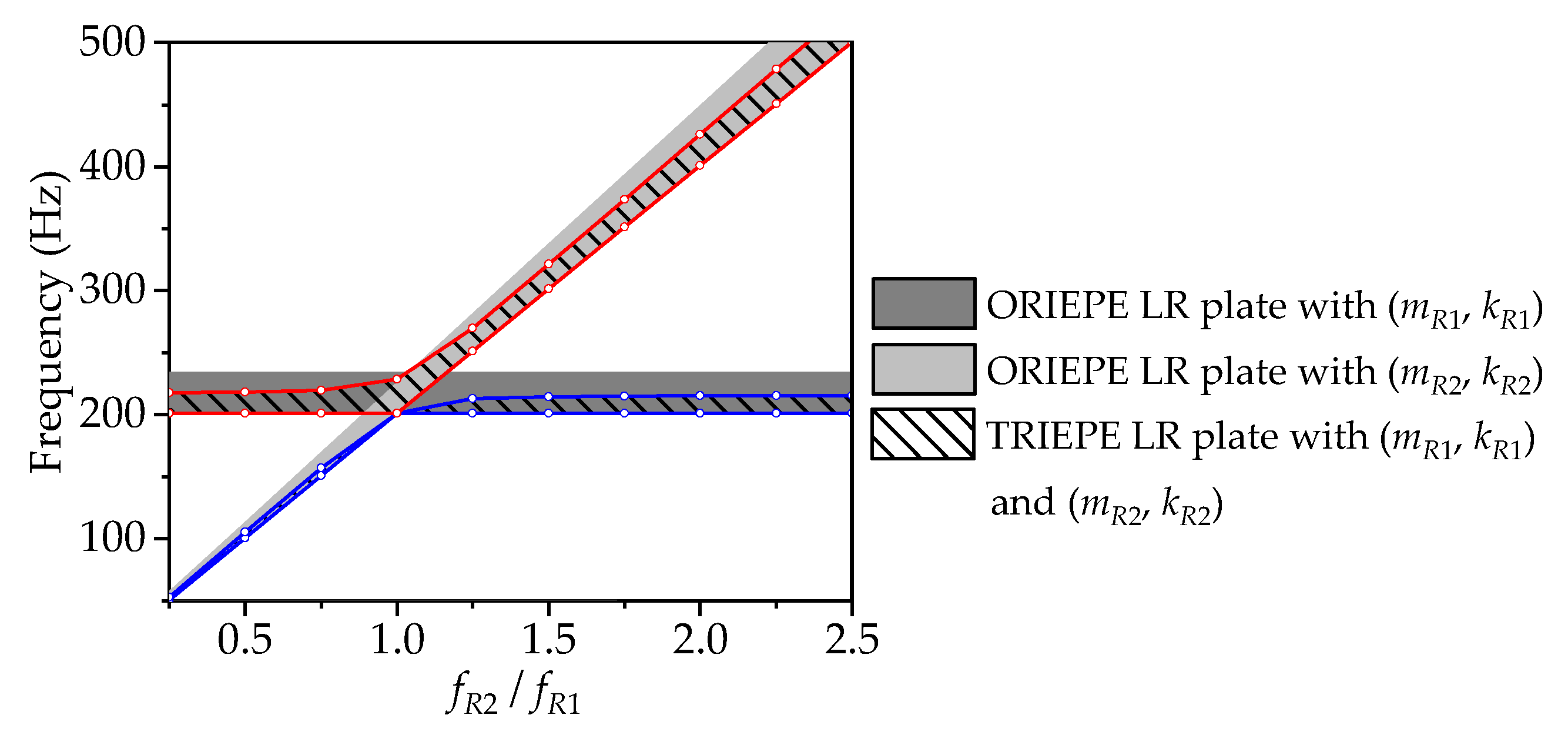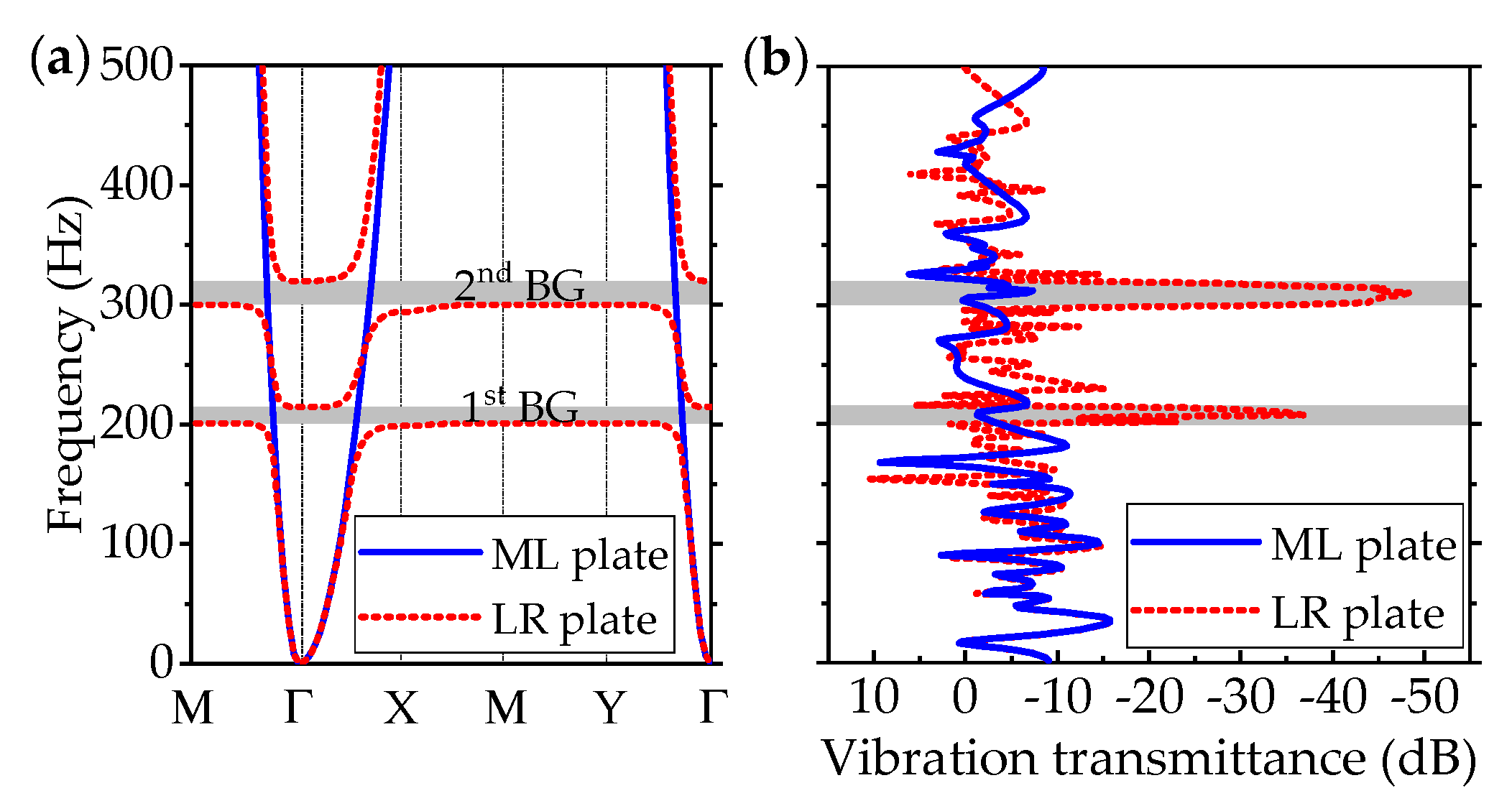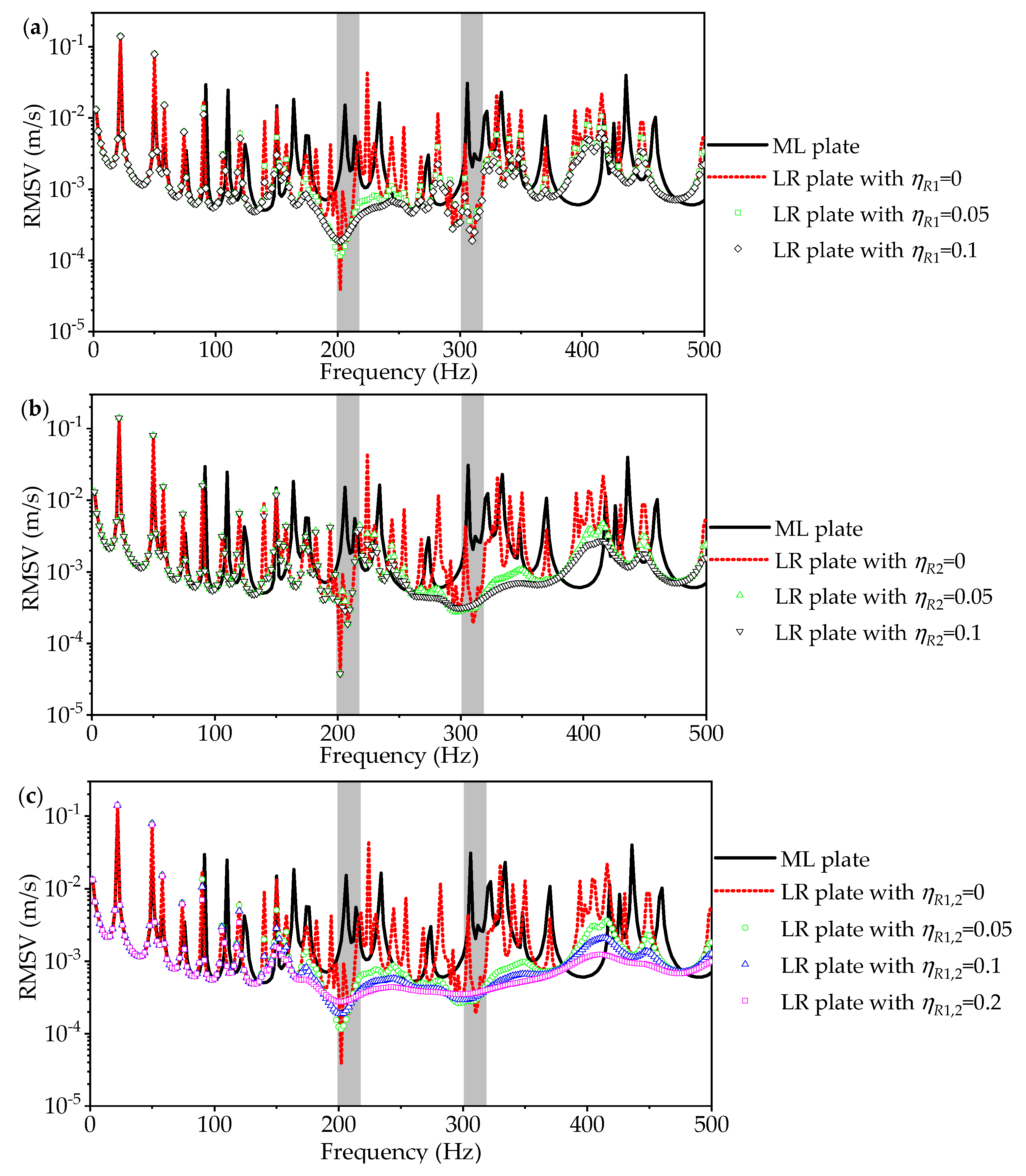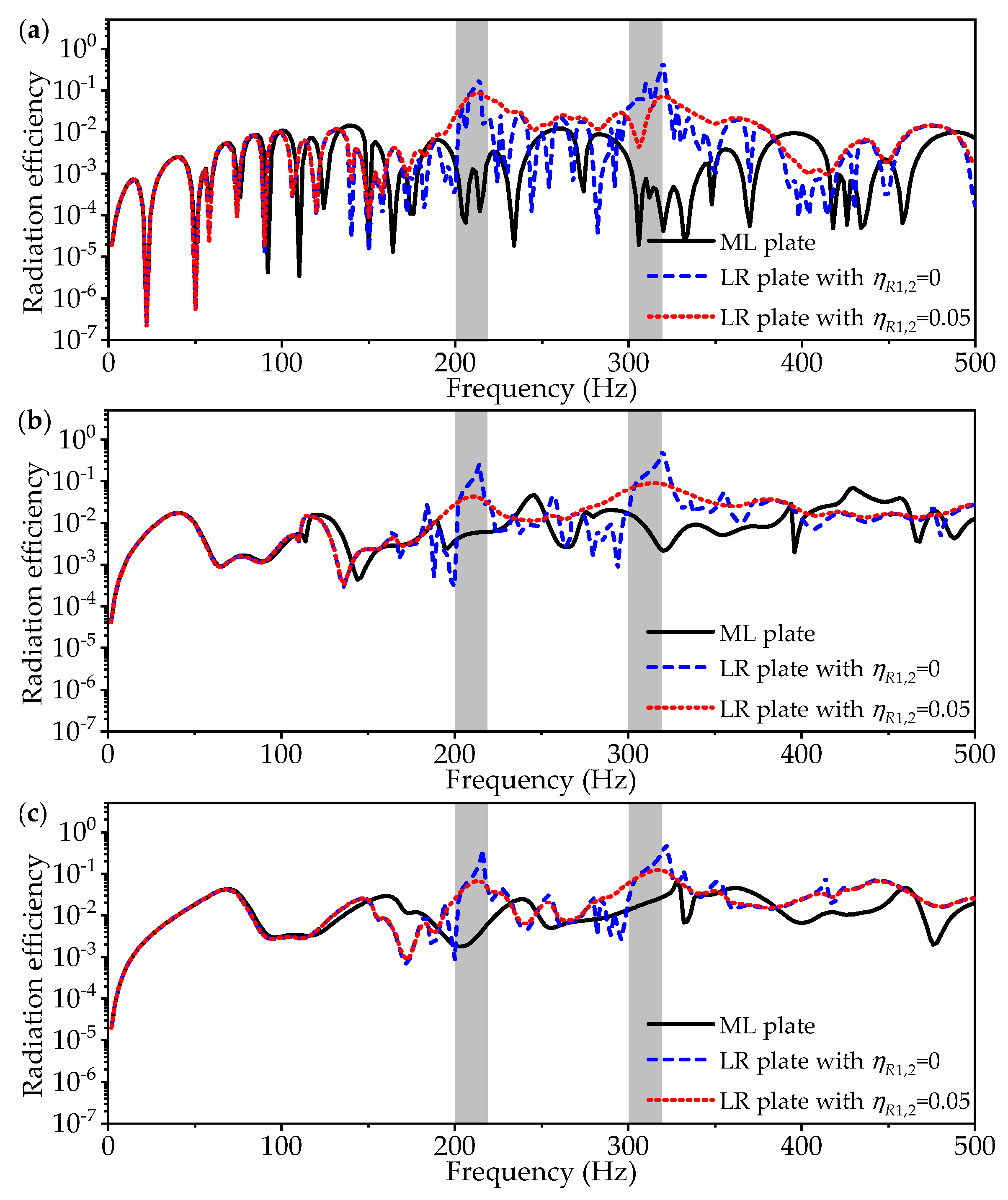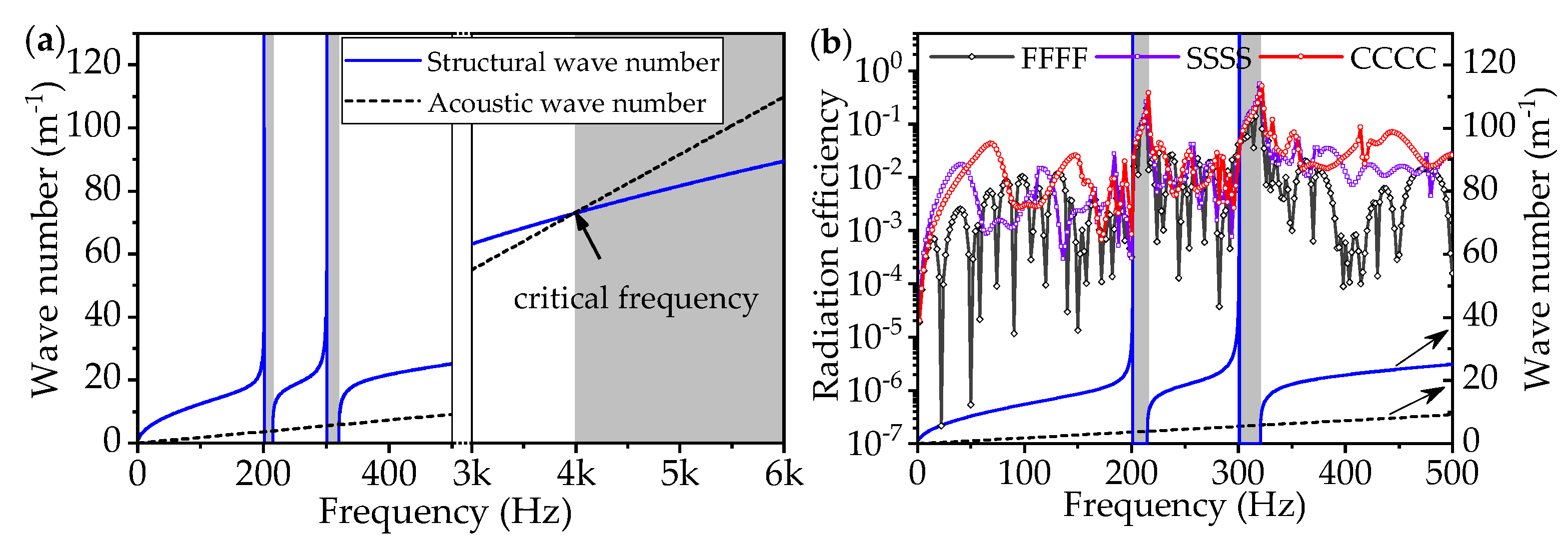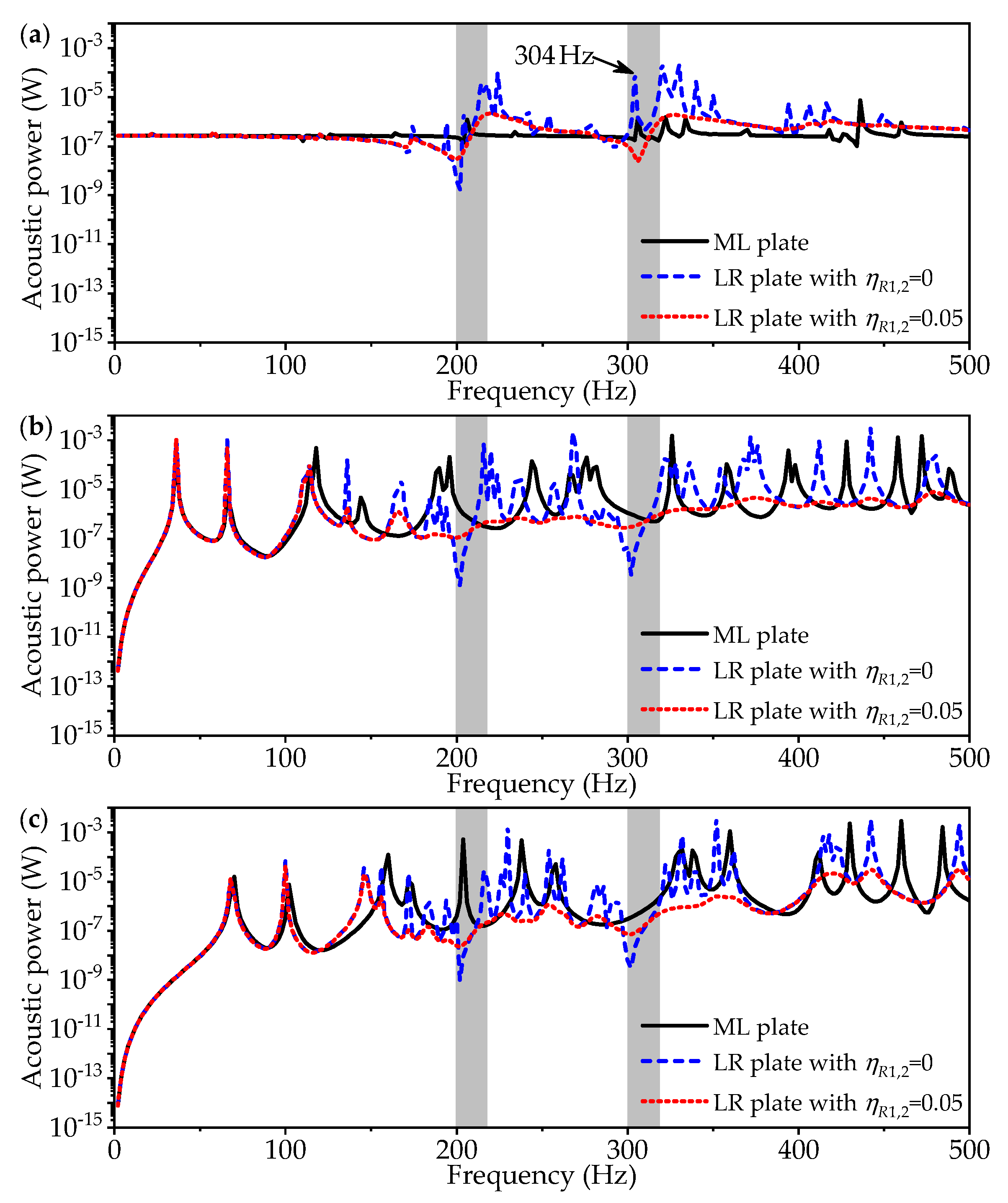3.1. Band-Gap Property and Vibration Attenuation
It should be noted that introducing a new type of resonator will affect the original band-gap frequency range in the LR plate with one resonator in each periodic element (ORIEPE LR plate), which is related to the spring-mass parameters of the new resonators. Thus, the effect of the ratio between the resonant frequencies on the band-gap frequency range is studied first of all. Since the complete band gaps are closely related to the LR mechanism in the LR plate system, directional band gaps are not considered in this paper. Shown in
Figure 3 are the trends of two band-gap frequency ranges versus
in the TRIEPE LR plate with resonators
and
, with the resonant frequencies of
and
, respectively. The band-gap frequency ranges in the two corresponding ORIEPE LR plates are also shown in
Figure 3 for comparison. The parameters
,
,
, and
are kept unchanged, while
is varied by changing
.
It can be seen in
Figure 3 that the single band gap in the ORIEPE LR plate with
is 201–233 Hz, as shown in the dark grey shaded area. The light grey shaded area shows that, within the frequency range of 0–500 Hz, with the increase of
, both the lower and upper frequencies of the single band gap in the ORIEPE LR plate with
keep increasing, and the lower frequency is very close to the resonant frequency
. When
, the lower frequencies of the two single band gaps are totally the same, while the difference between
and
makes the upper frequencies 233 Hz and 224 Hz, respectively, which means the resonator mass plays an important part in the determination of the upper frequency. Furthermore, it can be seen that the lower frequencies of the two single band gaps in both ORIEPE LR plates almost coincide with those of the two band gaps in the TRIEPE LR plate, while the band gaps in the former cases cover those in the latter case. In the TRIEPE LR plate with both
and
, when
, the band gap formed by the resonance of
is the 1st band gap. The 1st band gap is getting narrower as
approaches
, and meanwhile the 2nd band gap is getting wider. When
, the original 1st band gap vanishes and only one band gap exists. As
continues increasing, two band gaps reappear, while the band gap formed by the resonance of
turns into the 2nd band gap. The bandwidth of the 1st band gap is not changed after a slight increase, and the bandwidth of the 2nd band gap keeps increasing after a decrease.
Shown in
Figure 4 are the total bandwidths of the band gaps in three corresponding LR plates when
is below 500 Hz. The bandwidth of the band gap in the ORIEPE LR plate with
is 32 Hz. With the increase of
, the bandwidth in the ORIEPE LR plate with
has a nearly linear increase, which makes its bandwidth curve intersect with that in the ORIEPE LR plate with
when
reaches a certain value. Moreover, the curve of the total bandwidth of the two band gaps in the TRIEPE LR plate seems positively proportional to
with a lower slope than that in the ORIEPE LR plate with
. Interestingly, three bandwidth curves intersect at
, where the total bandwidths are all 32 Hz. With the exception of this point, the bandwidth in the TRIEPE LR plate stays between the bandwidths in both ORIEPE LR plates below 500 Hz.
It can be seen that when aiming to achieve a new low-frequency band gap, the introduction of the new periodic resonators might make the total bandwidth decrease in the TRIEPE LR plate. Appropriate spring-mass parameters for both kinds of resonators could make the total bandwidth not be greatly affected. Hence, the chosen parameters of the periodic element of the TRIEPE LR plate in this paper are given in
Table 1, together with the details of the finite base plate. In the following analysis, the parameters are kept unchanged unless otherwise stated.
As illustrated in
Section 2.1, the four boundaries of the plate are supported by a linear spring with stiffness
and a torsional spring with stiffness
. The free, simply supported, and clamped boundary conditions can be simulated by using specific stiffness values of
and
: the free boundary condition can be expressed when
and
; the simply supported boundary condition can be expressed when
tends to infinity and
; and the clamped boundary condition can be expressed when both
and
tend to infinity. The variation of the boundary conditions can result in the difference in the vibration response and acoustic performance [
29,
30]. In this paper, three kinds of different boundary conditions are applied to the plate, including fully free boundary conditions (‘FFFF’), fully simply supported boundary conditions (‘SSSS’), and fully clamped boundary conditions (‘CCCC’).
Before the analysis of the vibration attenuation property of the LR plate, taking the SSSS boundary condition as an example, the theory to simulate the vibration response in this paper is examined by using the FEM software of Ansys. The comparisons are shown in
Figure 5a–c, respectively for the bare plate, the mass-loaded (ML) plate, and the LR plate. The ML plate indicates the plate periodically attached with point masses, for which the plate, the lattice constant, and the loaded masses are all identical to those of the LR plate. The above theory is also appropriate for the ML plate via replacing Equation (21) by
. Good agreements can be found between the root-mean-square velocities (RMSVs) averaged over the whole surface calculated by the theory and FEM, which validates the correctness of the theory in this paper.
Shown in
Figure 6a are the band structure curves of the infinite bare plate, the infinite LR plate, and the infinite ML plate. The RMSVs averaged over the whole plate surface of the bare plate, the LR plate, and the ML plate, for the cases of various boundary conditions, are shown in
Figure 6b–d. In the range of 0–500 Hz, the band gaps induced by the LR effect are labeled in
Figure 6a, with band-gap frequency ranges of 201–215 Hz and 300–320 Hz, where no waves propagate. The two ranges correspond to the resonant frequencies of two kinds of resonators, i.e.,
and
. It can also be seen that, for the bare plate and the ML plate, waves are allowed at any frequency. The comparison between the band structures in
Figure 6a and the vibration results in
Figure 6b–d basically show a good coincidence between the band gaps of the infinite LR plate and the vibration attenuation bands of its finite counterpart, no matter what boundary conditions are applied to the finite plate. In the band-gap frequency ranges, the vibration of the finite LR plate is attenuated when compared with those of the bare plate and the ML plate.
As illustrated above, the ML plate and the LR plate have the same weight, heavier than the bare plate. From
Figure 6b–d, it is obvious that the first few modal frequencies of the bare plate are a little larger than those of the ML plate and the LR plate. Except for the effect on the structural vibration, the weight also affects the acoustic behavior [
22]. Thus, only the ML plate is considered for comparison below.
It is noted that the RMSV results in
Figure 6b–d are all averaged over the whole plate surface, which makes the vibration attenuation in the LR plates not very obvious at some frequencies in two band gaps, especially for the FFFF boundary conditions in
Figure 6b. In the finite LR plates, the vibration attenuation in the band-gap frequency ranges is usually evaluated by the vibration transmittance. With the band structure curves of the infinite ML and LR plates shown in
Figure 7a for comparison,
Figure 7b shows the vibration transmittances of the finite ML and LR plates with FFFF boundary conditions. The vibration transmittance is given by
, where the RMSVs averaged over the area of
and
within the base plate surface are chosen as
and
, respectively. From the comparison between the vibration transmittances of the ML and LR plates, it can be seen that the flexural waves in the LR plate can be dramatically suppressed in the band-gap frequency ranges, better revealing its band-gap property.
Figure 8a,b shows the displacement profiles of the LR plate at 202 Hz and 310 Hz, respectively within two band gaps. It can be seen that, with the exception of the area around the force position, the excited responses over almost the whole surface of the LR plate are significantly suppressed at the two frequencies.
For all of the above results of the LR plates, the damping characteristic of the resonators is not considered, while it could broaden the vibration attenuation band outside the band-gap frequency ranges [
21]. Shown in
Figure 9a–c are the RMSVs averaged over the whole surface of the FFFF ML plate and the FFFF LR plate with the
and
values of the resonators varying separately and simultaneously. When applying the damping loss factors to the resonator springs, it has little effect on the RMSV in a lower frequency range under 150 Hz in this case. With
kept as zero and
varied by 0, 0.05, and 0.1, the attenuation band covering the 1st band-gap frequency range becomes wider, though the RMSV in the original 1st band-gap frequency range is increased. Meanwhile, the RMSV within the 2nd band-gap frequency range changes little, as shown in
Figure 9a.
Figure 9b shows an analogous effect in the case where
is zero and
is varied by 0, 0.05, and 0.1. With the damping loss factor increasing simultaneously, as shown in
Figure 9c, the RMSV is decreased between the two band-gap frequency ranges, and a much wider attenuation band appears covering them. Moreover, the RMSV curves become smoother in the higher frequency range with the application of the resonator damping. It is revealed that a better attenuation performance can be achieved in the LR plate with multiple resonators when further considering their damping characteristic.
3.2. Acoustic Radiation Property of the Finite LR Plate
As derived in
Section 2.1 and
Section 2.2, the theory in this paper can calculate the radiation efficiencies of the finite LR plate with various boundary conditions.
Figure 10a–c gives the radiation efficiencies of the FFFF, SSSS, and CCCC plates, including the results of the ML plate, the LR plates with undamped resonators, and the LR plate with damped resonators of
. It is not difficult to observe that more peaks and dips appear in the curves of the RMSV and the radiation efficiency of the FFFF plates in 0–500 Hz, than in those in the case of greater constraints, such as the SSSS and CCCC boundary conditions simulated in this paper. Moreover, the modal frequencies shift to higher frequencies when more constraints are applied to the plate boundaries; for instance, the 1st modal frequencies of the LR plates with FFFF, SSSS, and CCCC boundary conditions are respectively 22 Hz, 36 Hz, and 69 Hz in this paper. As for the radiation efficiency, it can be easily seen from
Figure 10a–c that, in contrast to the vibration attenuation in the two band-gap frequency ranges, the radiation efficiency has been obviously increased in both bands compared with the results of the ML plates. When the resonators are damped, the curves become smoother than those in the undamped case from below the lower frequency of the 1st band gap, while the acoustic radiation is still high in the band-gap frequency ranges in each case.
It is known that the acoustic radiation from the infinite bare plate is effective only above the critical frequency [
31] where the acoustic wave number exceeds the structural wave number. For its finite counterpart, though its acoustic power can effectively radiate in the whole frequency range, the radiation efficiency reaches the highest at the critical frequency and tends to unity above the critical frequency. Based on this relationship, the structural and acoustic wave numbers of the infinite LR plate are then calculated. In an infinite LR plate with the wave vector
, the displacement function can be assumed as:
The substitution of Equation (42) into the governing equation of the infinite LR plate:
Yields:
where
is the structural wave number. To obtain the non-zero displacement responses of the base plate and the resonators, the matrix determinant of Equation (44) should equal zero, and then the structural and acoustic wave numbers can be obtained.
The structural and acoustic wave numbers of the infinite LR plate are compared in 0–500 Hz and 3–6 kHz, where the effective radiation frequency ranges are shaded, as shown in
Figure 11a. It can be seen that, besides the range where the infinite LR plate radiates sound effectively above the critical frequency of about 4 kHz, the acoustic wave number also exceeds the structural wave number in the two additional bands of 201–215 Hz and 300–320 Hz. The two bands coincide well with the band gaps, which means that the acoustic radiation from the infinite LR plate is effective in the band-gap frequency ranges. Therefore, the acoustic radiation from the finite LR plate of identical resonator parameters can reach a high effectiveness in the band-gap frequency ranges, as expressly shown in
Figure 11b. It can be seen that the radiation efficiencies of the finite FFFF, SSSS, and CCCC LR plates are sharply increased in two band-gap frequency ranges. Furthermore, by comparing the results of three different LR plates, the results behave almost the same and closer to unity in the band-gap frequency ranges. However, at most frequencies in 0–500 Hz, the greater the boundary conditions are, the higher the radiation efficiency of the LR plate is in this case.
Figure 12a–c shows the acoustic power radiated from the finite ML and LR plates with FFFF, SSSS, and CCCC boundary conditions. It can be observed from the comparison between
Figure 12a and
Figure 12b (or
Figure 12c) that the acoustic behavior behaves quite different when no constraints are applied to the plate. It has been explained in reference [
29] that the acoustic power in the low-frequency range radiated from the FFFF bare plate is mainly dominated by three rigid body modes. The rigid body motion and rotation of the FFFF plate make the first few flexural modes inefficiently radiating ones, and then the acoustic power at these modal frequencies is not highlighted, unlike the results of the finite plates with higher constraints. As shown in
Figure 12a, the acoustic power radiated from the ML plate is almost constant below 200 Hz in this case. For the LR plate, the radiated power is approximate to that from the ML plate in 0–100 Hz and is decreased below the lower frequency of the 1st band gap, while it turns out to be increased at a certain frequency within the band gap. A similar phenomenon is found around the 2nd band-gap frequency range.
For the LR plates with greater constraints, such as the SSSS and CCCC boundary conditions considered in this paper, it is expected that the acoustic power is decreased in the band-gap frequency ranges, as shown in
Figure 12b,c. It can be concluded that, although the radiation efficiency of the LR plate with greater constraints, is increased in the band-gap frequency ranges, due to the good performance of the vibration attenuation the acoustic power is reduced much in the same bands. Moreover, when considering the damping characteristic of the resonators, the acoustic power curve becomes smooth from below the lower frequency of the 1st band gap. Although the degree of acoustic power reduction in the band-gap frequency ranges is weakened, the attenuation band of acoustic radiation is broadened.
It can be seen that the application of the periodic resonators on the FFFF base plate cannot be a good noise-control method in this case, especially in and above the band gap frequency ranges. In fact, it can be understood from the vibration profile shown in
Figure 13a that the vigorously vibrating FFFF ML plate at the two frequencies may not radiate much sound power due to radiation cancellation from the uniform distribution of anti-phase regions. Conversely, though the vibration over the whole surface of the FFFF LR plate is not strong, as shown in
Figure 13b, the acoustic power radiated from the vibrating area near the excitation can be very high when no cancellation exists.
However, when considering the damping loss factors of the resonators, the high acoustic power radiated from the FFFF LR plate can be decreased. The vibration profile of the FFFF LR plate with damped resonators is shown in
Figure 14. It can be seen that the LR plate with undamped resonators in
Figure 13b vibrates vigorously near the excitation and hardly over the other surface. When replaced by damped resonators, the response of the FFFF LR plate is suppressed in the region where it is originally vibrating strongly, as shown in
Figure 14, and thus the radiated power is reduced. This is why the acoustic power radiated from the LR plate with undamped resonators is peculiarly high and decreased greatly after considering the damping characteristic of the resonators at 304 Hz, as shown in
Figure 12a.
Overall, the acoustic power radiated from the plates is related to their boundary conditions. For the FFFF ML plate, the radiation cancellation could appear more easily in a wide frequency range, and the plate radiates sound weakly. However, for the FFFF LR plate without good radiation cancellation, despite a lower RMSV in the band-gap frequency ranges, the higher radiation efficiency will translate to a higher acoustic power. In other cases where the base plate has greater constraints, such as the SSSS and CCCC LR plates in the manuscript, even though the radiation efficiency is higher in the band-gap frequency ranges, a lower RMSV will lead to a lower acoustic power.


